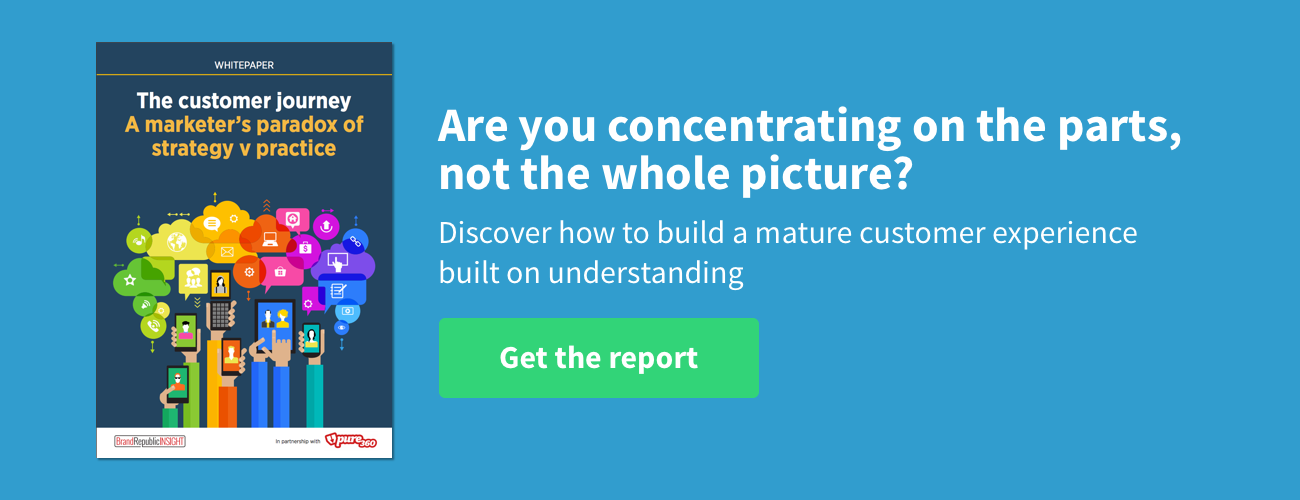For many agencies it’s not the technology or the ideas that hold them back – it’s their client’s culture.
Outdated attitudes, legacy systems and the age-old fear of doing things differently. For new approaches to thrive, thinking needs to change within these organisations. Clients need to embrace the new digital world and, most importantly, their customers.
Shaping a business around a customer’s needs is the most important step any business can make. Agencies are now commonly brought in by clients to not only provide the inspiration and technology, but also to give clients fresh ideas and new ways of thinking.
We take a look at some practical suggestions to introduce to clients that want to make the jump to putting the customer first. Here are some of the tools, theories and measurements you can introduce to reshape a business around the customer.
Map out a customer ecosystem
If clients want to mould their business around the customer then it’s not just the customer-facing parts of the business that need to change. The truth is that customer experience is impacted by every part of their organisation and there are a whole host of people, actions and systems involved.
Look at things in the business that need to work together to help the customer achieve their goals – the people, systems and actions. By doing this you’ll map out the customer’s ecosystem and the parts of the business that need to adapt.
Let’s look at an example: If you want to create flexible delivery options you’ll see it’s not just marketing that you need to influence. You’ll need to create conversations between logistics, the buying department and IT. Without addressing all the areas of the business involved, the change will be ineffectual and the customer’s goals won’t be reached. Creating customer-focused conversations will give departments that aren’t outward-facing a better understanding of the consumer’s needs, which will undoubtedly improve the focus of the business for everyone’s benefit.
Structure your business around customer needs
Often we structure business around outdated systems and internal targets. People are limited by strict remits or departmental goals, meaning the buck often gets passed. The most innovative organisations are now looking at structuring their businesses around the needs of the customer.
In the world of omni-channel experiences, retailers are beginning to focus not on the channels but on the outcomes when structuring departments. Instead of the online and stores team they’ll soon be the pre-sales, transaction and post-sales teams. The future of retail will be literally moulded around how the customer interacts with the business. By re-imagining departments and creating new structures based around the path-to-purchase, silos will be broken down and information will flow more easily within the company.
Measuring customer satisfaction
Forward-thinking organisations like Apple are increasingly using customers’ perceptions of their brand as measures of success. Instead of sales-focused key performance indicators such as units, volume and margin, they’re also introducing measures of how likely people are to recommend their service and products.
Apple use Net Promoter Scores (NPS) to measure how likely a customer is to recommend a company’s services or products to others (Forbes, 2011). It’s a useful tool to gauge the customer’s overall satisfaction and loyalty. By using NPS as a measurement of success you automatically mould a business around the needs of the customer instead of looking solely on the internal pressures of sales or targets – numbers that don’t have the customer’s interests at heart. By making what the customer thinks a key performance indicator you’re automatically improving your level of service and the subsequent loyalty of impressed consumers.
It’s about lifetime value – not just short-term sales
Interesting content, useful tips, reviews and helpful advice all build a relationship with customers and should always be included in your email strategy, but they may not generate short-term sales. The pay-off in creating communications centred around the customer’s needs, instead of a business’s commercial needs, is loyalty. Customer-led communications build-up a relationship over time, meaning customers are more likely to stay loyal and buy more over a longer period of time. Smart businesses measure the impact of customer-led activity by looking at the value of the customer’s business over their entire lifecycle. It’s a great way to measure loyalty and its impacts on sales.
Lifetime Value (LTV) is a metric that takes a little effort to calculate and will tell you which customers to invest your time in. There are a few ways to do this but the simplest is to add up all the gross profit from offline and online purchases for each individual customer. This can be useful when identifying customers who may spend infrequently at times such as Christmas, but have a high basket value and are worth retaining. If you opt for this measurement then you’re in good company – it’s a metric commonly used by Starbucks to work out the value of their customers (Kissmetrics).
So there you are – a few practical steps you can introduce to your clients to start to change their culture. Tangible actions that will give you the freedom to create more innovative customer-focused campaigns, improve customer satisfaction and loyalty.

